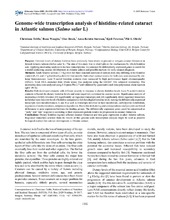| dc.contributor.author | Tröße, Christiane | en_US |
| dc.contributor.author | Waagbø, Rune | en_US |
| dc.contributor.author | Breck, Olav | en_US |
| dc.contributor.author | Stavrum, Anne-Kristin | en_US |
| dc.contributor.author | Petersen, Kjell | en_US |
| dc.contributor.author | Olsvik, Pål A. | en_US |
| dc.date.accessioned | 2010-06-09T09:00:43Z | |
| dc.date.available | 2010-06-09T09:00:43Z | |
| dc.date.issued | 2009-07-09 | eng |
| dc.Published | Molecular Vision 15: 1332-1350 | en |
| dc.identifier.issn | 1090-0535 | |
| dc.identifier.other | http://www.molvis.org/molvis/v15/a141 | eng |
| dc.identifier.uri | https://hdl.handle.net/1956/3967 | |
| dc.description.abstract | Purpose: Elevated levels of dietary histidine have previously been shown to prevent or mitigate cataract formation in farmed Atlantic salmon (Salmo salar L). The aim of this study was to shed light on the mechanisms by which histidine acts. Applying microarray analysis to the lens transcriptome, we screened for differentially expressed genes in search for a model explaining cataract development in Atlantic salmon and possible markers for early cataract diagnosis. Methods: Adult Atlantic salmon (1.7 kg) were fed three standard commercial salmon diets only differing in the histidine content (9, 13, and 17 g histidine/kg diet) for four months. Individual cataract scores for both eyes were assessed by slitlamp biomicroscopy. Lens N-acetyl histidine contents were measured by high performance liquid chromatography (HPLC). Total RNA extracted from whole lenses was analyzed using the GRASP 16K salmonid microarray. The microarray data were analyzed using J-Express Pro 2.7 and validated by quantitative real-time polymerase chain reaction (qRT–PCR). Results: Fish developed cataracts with different severity in response to dietary histidine levels. Lens N-acetyl histidine contents reflected the dietary histidine levels and were negatively correlated to cataract scores. Significance analysis of microarrays (SAM) revealed 248 significantly up-regulated transcripts and 266 significantly down-regulated transcripts in fish that were fed a low level of histidine compared to fish fed a higher histidine level. Among the differentially expressed transcripts were metallothionein A and B as well as transcripts involved in lipid metabolism, carbohydrate metabolism, regulation of ion homeostasis, and protein degradation. Hierarchical clustering and correspondence analysis plot confirmed differences in gene expression between the feeding groups. The differentially expressed genes could be categorized as “early” and “late” responsive according to their expression pattern relative to progression in cataract formation. Conclusions: Dietary histidine regimes affected cataract formation and lens gene expression in adult Atlantic salmon. Regulated transcripts selected from the results of this genome-wide transcription analysis might be used as possible biological markers for cataract development in Atlantic salmon. | en_US |
| dc.language.iso | eng | eng |
| dc.publisher | Molecular Vision | eng |
| dc.relation.ispartof | <a href="http://hdl.handle.net/1956/3961" target="blank">Mechanisms of cataract development in adult Atlantic salmon growers relative to dietary histidine and plant feed ingredients</a> | eng |
| dc.title | Genome-wide transcription analysis of histidine-related cataract in Atlantic salmon (Salmo salar L) | en_US |
| dc.type | Peer reviewed | |
| dc.type | Journal article | |
| dc.rights.holder | Copyright 2009 Molecular Vision. All rights reserved. | |
| dc.rights.holder | Molecular Vision | |
| dc.identifier.cristin | 351906 | |
| dc.subject.nsi | VDP::Landbruks- og Fiskerifag: 900::Fiskerifag: 920::Fiskehelse: 923 | nob |
